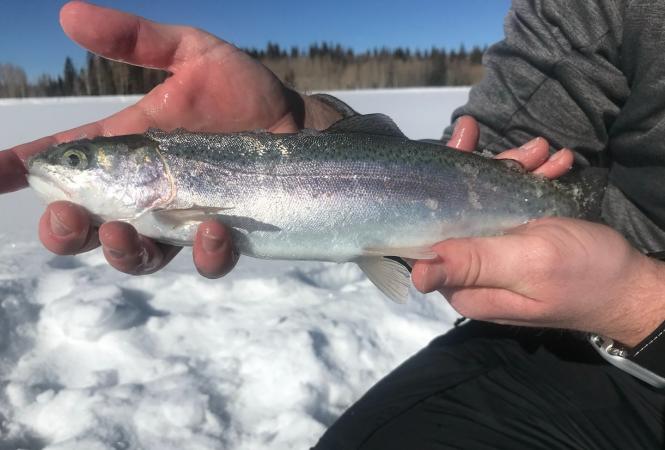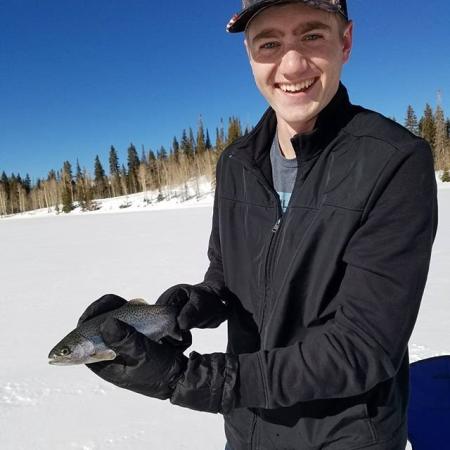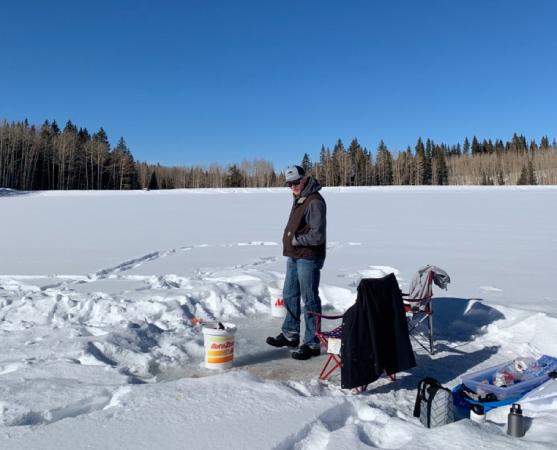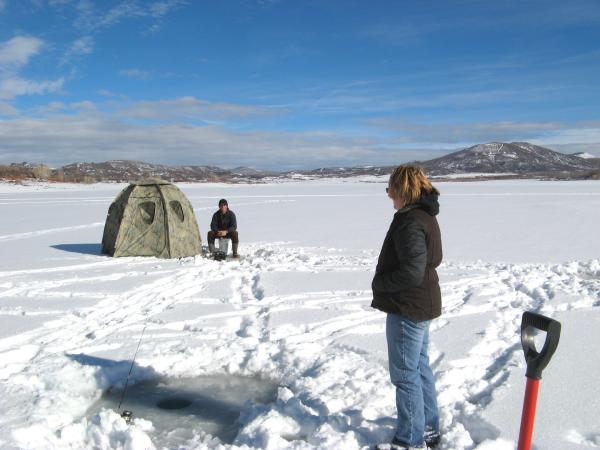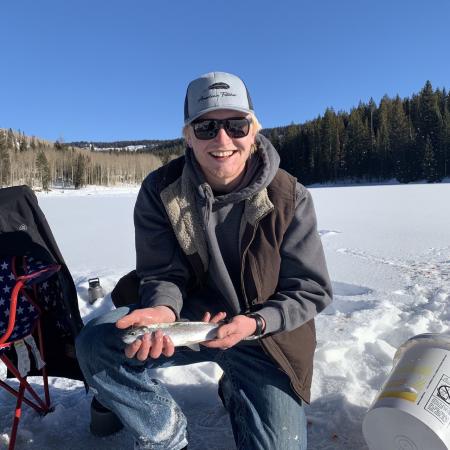5 Minute Read
You don’t need warm weather to enjoy the great outdoors in Colorado. Every year, people flock to the state’s frozen bodies of water, hoping to reel in an impressive catch.
Between December and March, Colorado’s reservoirs and lakes become lined with a thick layer of ice, where dropping a line and spending days soaking in the cool landscapes becomes second nature. Some dedicated individuals even bring portable fishing shelters and electronic fish locators to up the ante.
To help you prepare for your time on the ice, we’ve put together this guide to ice fishing in Colorado. Grab your bait, layer up and dive in (not literally, of course).
What is Ice Fishing?
First, a quick explanation of what ice fishing is. The sport is oriented around catching fish through a small opening in a frozen body of water. The opening is normally a spherical hole, about 10 inches or less in diameter, made with a saw or an auger.
The Best Time to Go Ice Fishing in Colorado
Ice fishing in Colorado is most common from December through February, but the best time to fish depends on the conditions. The thickness of the ice is extremely important, so be sure to check the ice report before heading out. A good rule of thumb is if the ice is less than four inches thick, you should not walk on it. If you’re using a sled to go ice fishing, used to carry supplies, you’ll need an ice thickness of at least 6 inches.
It’s worth knowing that lake water freezes faster as elevation increases. If you’re fishing at 8,000 feet or below, the water will take longer to solidify – especially in the early weeks of winter. For lower altitudes, it’s wise to do some research beforehand to confirm that the conditions are safe for fishing. Reaching out to local public land partners will provide you the assurance you are looking for. Colorado Parks and Wildlife has regular online updates about ice fishing conditions for the state parks, or you can ask a local bait shop or a park ranger.
Colorado Ice Fishing Regulations
Before fishing in Colorado no matter what the season, you’ll need to purchase a Colorado fishing license. This can be bought online or in person from any Colorado Parks and Wildlife Visitor Center.
For ice fishing specifically, there are a few rules to follow. The hole you create or use for fishing can be no bigger than 10 inches in diameter, and you can’t have more than two lines in the hole at the same time. If you want to use two holes with a line in each, you’ll have to add an extra rod stamp to your license. These stipulations can be found on the Colorado Parks and Wildlife website.
Keep in mind that having a license does not give you automatic access to icefish anywhere in Colorado. There are restricted areas and lakes where ice fishing is prohibited altogether. Always check in advance to confirm if you can fish in your desired spot and ask a local angler shop if there are other considerations you need to accommodate.
The full documentation of ice fishing regulations in Colorado can be found here.
Ice Fishing Safety Tips
While ice fishing can be a relaxing activity, it is always best to plan ahead to avoid the unexpected. Most accidents involve slipping and falling on the ice. To prevent slipping, invest in a pair of shoe spikes, yak tracks or ice cleats, which are traction devices that attach to your shoes and give you extra grip when walking on slippery surfaces.
Additionally, be sure to pay close attention to the weather conditions. If the daily high temperatures aren’t exceeding freezing, the ice is more likely to stay thick and hard. If there is a fluctuation in temperatures or they consistently rise above freezing, you may want to postpone your ice fishing plans.
Once you are ready to venture out onto the lakes, test the ice before you walk on it. Throw heavy rocks onto the surface or hit a spud bar (ice chisel) or metal rod against the ice, near the shoreline, to check the thickness. Repeat these actions every 15 to 20 feet as you walk further out on the ice. If there are any signs of cracks or instability in the surface, slowly but immediately return to land.
Be aware that the thickness of ice can change suddenly on the same body of water. Clear ice is stronger than gray or cloudy ice, and ice that is formed by strong currents, from a creek, river, inlet or overflow can be very weak. Factors like the amount of snow accumulated on the ice and the number of fish can also affect how thick the ice is.
Lastly, always wear a lifejacket when ice fishing, carry a spare change of clothes with you, pack a rope of about 20 feet in length and keep a small ice pick around your neck in case of an emergency to lift yourself out of the water. It’s also recommended to go ice fishing with someone, to make sure that you have help if you do get into trouble. If you opt to go solo, be sure to tell people where you’re going, including the actual lake or body of water, and when you expect to return.
Best Grand Junction Ice Fishing Locations
Nestled on the Western side of Colorado, Grand Junction is a bustling community and a favorite destination for ice fishing hobbyists during the winter months. Outlined below are a few of our favorite locations for ice fishing around Grand Junction.
Grand Mesa
At about 40 miles long, the Grand Mesa is the largest flat-top mountain in the world and is home to more than 300 alpine lakes. Sunset Lake and Island Lake are particularly great for ice fishing because they are both stocked with catchable trout and have been the source of some champion Snake River cutthroat and brook trout catches. Both Sunset and Island Lake are easily accessible because they are only a short walk from the parking lots. Island Lake is the largest lake on the Grand Mesa.
Vega Reservoir
Perched on the north side of the Grand Mesa, Vega Reservoir is a beautiful state park and is perfect for ice fishing - especially if you are looking to reel in some rainbow and cutthroat trout. There are also multiple parking lots around the lake, which makes it easy to access a variety of fishing holes. This February 2023 report shows conditions are good.
Ice fishing is one of the many exciting outdoor activities that Grand Junction has to offer. The area is known as an outdoor recreation mecca. Ready to cast your line further into the area? Check out the Official Grand Junction Visitor Guide to help plan your trip.



